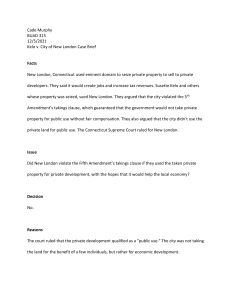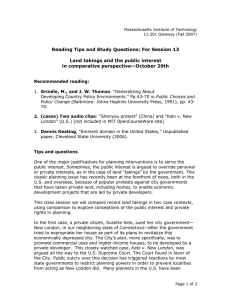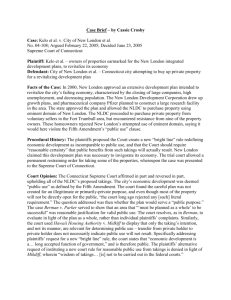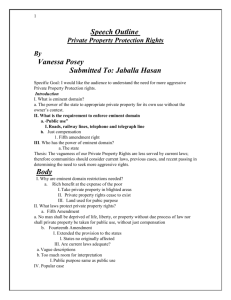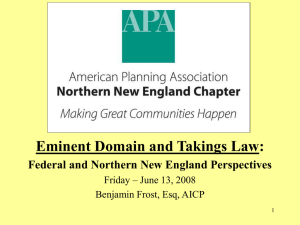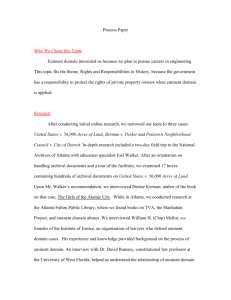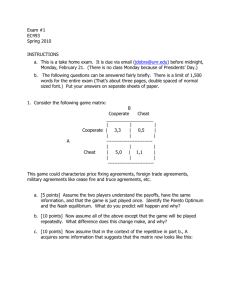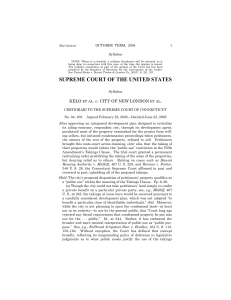Kelo v. City of - Northern Illinois University
advertisement
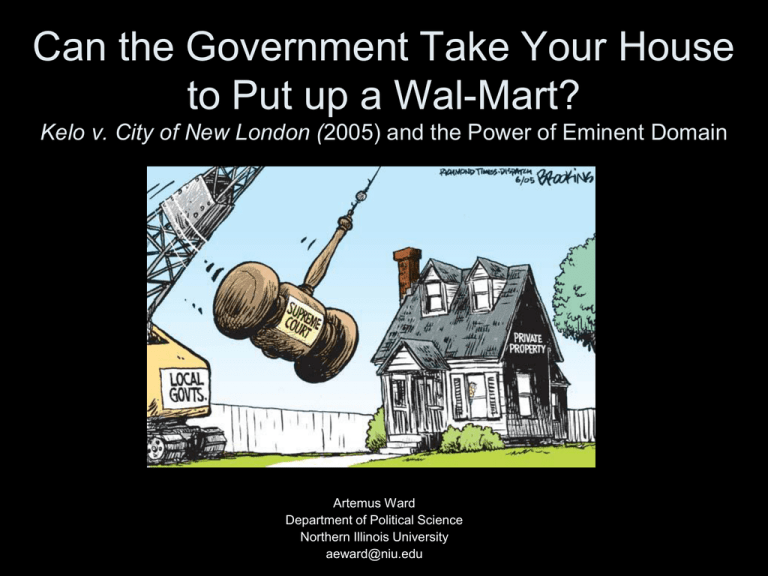
Can the Government Take Your House to Put up a Wal-Mart? Kelo v. City of New London (2005) and the Power of Eminent Domain Artemus Ward Department of Political Science Northern Illinois University aeward@niu.edu • • • • Imagine that one day you own your own home, your dream house in fact. It is in perfect condition. You have raised your kids there. It is the only home they know. They attend the excellent local school down the street. Your neighbors are your best friends and each day all of the neighborhood kids play to together. One day you get a letter from the government explaining that they have “condemned” your house so that they can build a new superhighway. The letter further explains that they will pay you $100,000, what they consider “fair market value,” and that you have to vacate your home within 6 months. Can the government do this? Yes. Eminent Domain is the power of the government to take private real estate without the owner’s permission. Eminent Domain The Takings Clause • • • • The 5th Amendment to the U.S. Constitution states: “nor shall private property be taken for public use, without just compensation.” This provision assumes that the government has the power of eminent domain and imposes a limit on the government’s power: property must be taken for “public use” and “just compensation” must be provided. At the founding, many states protected private property through similar laws and it was understood that the Takings Clause only applied to the federal government. Chief Justice John Marshall affirmed this view in Barron v. Baltimore (1833) where the Supreme Court ruled that the Bill of Rights only applied to the federal government and not to state or local governments. • • • • • With the passage of the 14th Amendment after the Civil War, lawyers began arguing that the provisions of the Bill of Rights, including the 5th Amendment’s Takings Clause, now applied to the states. Among other things, the 14th Amendment states: “nor shall any State deprive any person of life, liberty, or property, without due process of law.” In Chicago, Burlington, and Quincy Railroad v. Chicago (1897) the Supreme Court held that this provision—the Due Process Clause—“incorporated” the 5th Amendment’s Takings Clause, making it applicable to state governments. The Court reasoned that if the government was going to take private property, “due process” required that it be taken for “public use” and that “just compensation” was given. Justice John Marshall Harlan wrote for the 7-1 majority: “The legislature may prescribe a form of procedure to be observed in the taking of private property for public use, but it is not due process of law if provision be not made for compensation. Notice to the owner to appear in some judicial tribunal and show cause why his property shall not be taken for public use without compensation would be a mockery of justice. Due process of law, as applied to judicial proceedings instituted for the taking of private property for public use means, therefore, such process as recognizes the right of the owner to be compensated if his property be wrested from him and transferred to the public.” Incorporation What Constitutes a “Public Use” Early Limits • • • • • Though there has been disagreement about exactly what constitutes a government “taking” and what is “just compensation,” it is the “public use” provision that we will focus on in this lecture. Usually “public use” is obvious such as when a government wants to build a courthouse, road, school, or park. Prior to the New Deal in the 1930s, the Supreme Court took a strict interpretation of “public use” and disallowed a number of government attempts to take private property. For example, in Cole v. LaGrange (1884) the city of LaGrange, Missouri issued bonds to help finance the operation of a private iron and steel mill. The Supreme Court held that this was not a proper “public use.” The Court invalidated other takings for failing to qualify as “public use” in Missouri Pacific Railway Company v. Nebraska (1896) and Cincinnati v. Vester (1930). What Constitutes a “Public Use” Modern Expansion • • • • After the New Deal the Supreme Court’s position began to change. In a series of unanimous opinions the justices increasingly deferred to legislatures to determine what constituted “public use.” In United States ex rel. Tennessee Valley Authority v. Welch (1946) the justices upheld the authority of the federal government to condemn private land that would be flooded as a result of the TVA’s flood control programs. In Berman v. Parker (1954) the Court failed to provide relief to a landowner whose property, which was in a blighted area, was taken from him as part of an urban renewal project but later was transferred to another private party. Justice William O. Douglas reasoned that aesthetics and beautification qualified as a legitimate “public purpose.” In Hawaii Housing Authority v. Midkiff (1984) the Court upheld a state plan to redistribute land by forcing large landowners to sell their properties to the people who leased them. Justice Sandra Day O’Connor reasoned that the “public use” requirement is satisfied as long as the taking is rationally related to some conceivable public purpose; it is the purpose of the taking, not the use of the property, that is important. Kelo v. City of New London (2005) The Facts • • • • • • • For decades the city of New London, Connecticut suffered significant economic decline. By 1998 the unemployment rate was double that of the state and the population had declined to 24,000, the same number of residents the city had in 1920. In response, state and local officials created the New London Development Corp. (NLDC) to devise strategies for economic advancement. The Pfizer drug company already had a research facility in New London but tentatively committed to build a new $300 million research facility in the city’s Fort Trumbull area. Officials believed that the new development would not only bring jobs and tax revenues to the city but also would spur other economic revitalization efforts. The NLDC developed a master plan for the areas surrounding the proposed Pfizer operation calling for a hotel, conference center, museum, restaurants, shops, office space, marina, river walk, and new residential housing. In 2000 the city adopted the plan. To begin the development, however, the city had to acquire 115 parcels of privately owned land. The city successfully negotiated with most of the owners to purchase their land but some refused to sell. The city responded by condemning their properties through their power of eminent domain. Nine landowners, including Susette Kelo, filed suit. She had owned a waterview home since 1997 and has spent considerable funds to fix it up. Another owner, Wilhelmina Dery, was born in and had lived in her home since 1918. None of the homes were in poor condition and the area was not blighted. The court ruled 5-4 in favor of the government. The justices in the majority were (from right): John Paul Stevens, Anthony Kennedy, Ruth Bader Ginsburg, Stephen Breyer, and David Souter—the Court’s most liberal members. • • • • • • • In a 5-4 decision, the Court upheld the takings. Writing for the majority, Justice Stevens explained that simply taking Justice A’s property and giving it to B is unconstitutional. Yet this taking was executed pursuant to a “carefully considered” development plan and John Paul therefore satisfies the public use requirement. Stevens Stevens explained that the Court long ago rejected the 19th-century “common carrier” idea – that “public use” means “used by the public.” He cited Berman v. Parker and Midkiff to explain that legislatures are Delivered the entitled to determine what “public use” entails: “For more than a century, our public use jurisprudence has wisely eschewed rigid Opinion of the formulas and intrusive scrutiny in favor of affording legislatures broad Court latitude in determining what public needs justify the use of the takings power.” He recognized that while the properties and area were not blighted, the city determined “that the area was sufficiently distressed to justify a program of economic rejuvenation” and “promoting economic development is a traditional and long accepted function of government” which cannot be distinguished from other public purposes that the Court has upheld. Stevens said that the Court does not review the plan itself: “It is not for the courts to oversee the choice of the boundary line nor to sit in review on the size of a particular project area. Once the question of the public purpose has been decided” the plan is totally at the discretion of the legislative branch. Finally, he said that people can work within their states to protect their property from condemnation: “We emphasize that nothing in our opinion precludes any State from placing further restrictions on its exercise of the takings power…. the necessity and wisdom of using eminent domain to promote economic development are certainly matters of legitimate public debate.” Justice Anthony Kennedy Concurring • • • • In 5-4 decisions, Justice Kennedy more-often-than-not sides with his conservative colleagues. But on occasion, as in this case, he sides with the more liberal members of the Court. He wrote separately to emphasize that point that transfers must chiefly benefit the public and not the private entity that the land is transferred to. “A court applying rational-basis review under the Public Use Clause should strike down a taking that, by a clear showing, is intended to favor a particular private party, with only incidental or pretextual public benefits.” “While there may be categories of cases in which the transfers are so suspicious, or the procedures employed so prone to abuse, or the purported benefits are so trivial or implausible, that courts should presume an impermissible private purpose, no such circumstances are present in this case.” Justice Sandra Day O’Connor Dissenting • • • “Under the banner of economic development, all private property is now vulnerable to being taken and transferred to another private owner, so long as it might be upgraded—i.e., given to an owner who will use it in a way that the legislature deems more beneficial to the pubic—in the process.” Property could be transferred for “increased tax revenue, more jobs, maybe even aesthetic pleasure.” She explained that Berman and Midkiff (in which she wrote the majority opinion allowing the taking) were different from this case: “In both those cases, the extraordinary, precondemnation use of the targeted property inflicted affirmative harm on society—in Berman through blight resulting from extreme poverty and in Midkiff through oligopoly resulting from extreme wealth. And in both cases, the relevant legislative body had found that eliminating the existing property use was necessary to remedy the harm. Thus a public purpose was realized when the harmful use was eliminated. Because each taking directly achieved a public benefit, it did not matter that the property was turned over to private use. Here, in contrast, New London does not claim that Susette Kelo’s and Wilhelmina Dery’s well-maintained homes are the source of any social harm.” Finally, she explained that the majorities call for people to work through their state legislature to protect their property was unrealistic: “The beneficiaries are likely to be those citizens with disproportionate influence and power in the political process, including large corporations and development firms. As for the victims, the government now has license to transfer property from those with fewer resources to those with more. The Founders cannot have intended this perverse result.” Justice Clarence Thomas Dissenting • As he has done with many areas of the law, Justice Thomas expressed his dissatisfaction with the current debate and his preference for a new approach to this issue. • “I would revisit our Public Use Clause cases and consider returning to the original meaning of the Public Use Clause: that the government may take property only if it actually uses or gives the public a legal right to use the property.” • Echoing Justice O’Connor’s dissent, Thomas portrays the majority as protecting the powerful and uncaring about the poor. • “Allowing the government to take property solely for public purposes is bad enough, but extending the concept of public purpose to encompass any economically beneficial goal guarantees that these losses will fall disproportionately on poor communities. Those communities are not only systematically less likely to put their lands to the highest and best social use, but are also the least politically powerful.” There was considerable public criticism of the Court’s decision. Aftermath: Condemning the Justices • • • In addition to protective legislation, the decision touched off a storm of protests including some targeted at the justices themselves. In Weare, New Hampshire, activists secured enough signatures on a petition to place a proposal on the ballot to have the town seize the 200-year-old farmhouse home of Justice David Souter, who voted with the majority. Under the proposal the property would be turned over to private investors who would build an inn to be named the “Lost Liberty Hotel,” featuring the “Just Deserts” café. One supporter said, “It would be more like a bed and breakfast…. There would be nine suites, with a black robe in each of the closets.” The proposal was rejected 1167 to 493. In a related but also unsuccessful effort, members of the state Libertarian Party urged the city of Plainfield, New Hampshire, to seize a 167-acre vacation retreat owned by Justice Stephen Breyer, also a member of the Kelo majority. In its place they planned to create a “Constitution Park” including monuments to the U.S. and New Hampshire constitutions. Aftermath: Justice Stevens Speaks • • • • In August 2005, Justice Stevens spoke at a meeting of the American Bar Association. He called his positions in both the medical marijuana case Gonzales v. Raich (2005) and Kelo, “unwise” but explained that “in each I was convinced that the law compelled a result that I would have opposed if I were a legislator.” In Kelo, he explained that the result he reached as a judge was “entirely divorced from my judgment concerning the wisdom of the program.” He said that his own view on eminent domain was that “the free play of market forces is more likely to produce acceptable results in the long run than the best-intentioned plans of public officials.” In 2007, Stevens said in an interview, “As you know there are pressure groups that have very strong feelings about property rights. I sympathize with all that, but I thought that was a clear case of what the law compelled. It’s part of the job to write unpopular decisions. No doubt about it.” Taking a queue from Stevens’ Kelo opinion, 30 state legislatures immediately introduced bill and constitutional amendments to restrict local government’s use of eminent domain. Ten states already had laws baring government seizures of non-blighted private property for economic development purposes. Aftermath: Dery and Kelo • Wilhelmina Dery died in her home, which had yet to be seized by the government, one year after the Court’s decision. • As for Susette Kelo, the New London nurse continued the fight to save her home from government seizure. • During the summer of 2006, Kelo and the city reached a compromise solution. • The city agreed to fund the physical relocation of the house to a nearby lot. • Kelo lost her waterview location, but saved the 1893 home she had spent many years renovating. Aftermath: Pfizer • • • • In total, the state paid $78 million to purchase and bulldoze the land for the development project. Yet in the end, nothing was ever built. In 2009 Pfizer merged with Wyeth and because both had facilities in Connecticut, one was closed – the original Pfizer research and development campus in New London (above) – and most of the workers were transferred to the other Connecticut facility. In the aftermath of 2011's Hurricane Irene, the New London development was turned into a dump for storm debris such as tree branches and other vegetation. Bibliography • • Epstein, Lee and Thomas G. Walker. 2007. Constitutional Law for a Changing America: Institutional Powers and Constraints. Washington, DC: Congressional Quarterly Press. Greenhouse, Linda. 2005. “Justice Weighs Desire v. Duty (Duty Prevails).” New York Times. August 25. http://www.nytimes.com/2005/08/25/politics/25memo.html.
